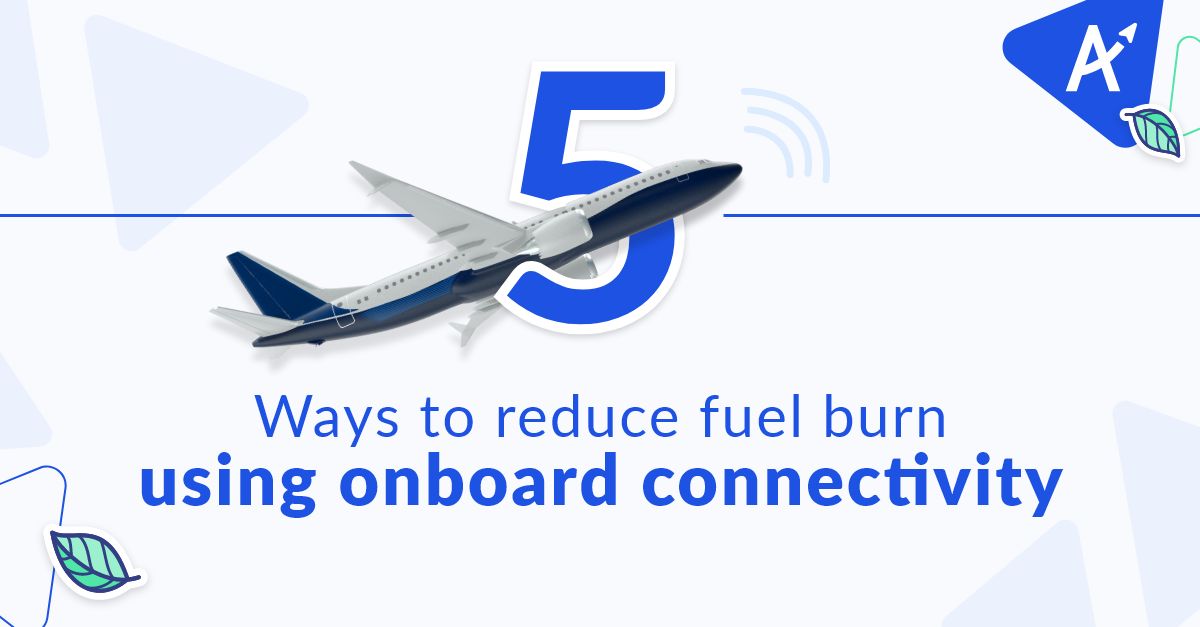5 ways to reduce fuel burn using aircraft connectivity.
In today's fast-changing aviation landscape, airlines grapple with rising fuel costs and the urgent need to rapidly decarbonize their operations. Optimizing fuel efficiency is a top priority to balance economic performance and environmental stewardship. Operators are actively working to reduce fuel consumption and implement ambitious fuel efficiency programs. However, there is still a significant area for improvement that airlines struggle to address: in-flight operations.
In recent years, clear strides in the field of aircraft connectivity, machine learning, and data analytics have opened up a new realm of possibilities for fuel optimization. These technologies enable airlines to enhance fuel efficiency in the cockpit by leveraging real-time data insights. Such advancements supplement existing fuel conservation strategies, offering a way to further optimize operations and fuel efficiency.
This article explores how fuel efficiency teams and Electronic Flight Bag (EFB) Managers can get extra savings by leveraging their flight real-time data thanks to better aircraft connectivity.
|
Summary |
Accessing real-time flight data.
Real-time information can be a game-changing factor for decision-making in the industry. This also applies to airlines’ fuel efficiency operations. Real-time data enables pilots and ground teams to make better tactical & contextualized decisions to optimize fuel usage.
There are two kinds of real-time information that can help teams yield more savings: real-time access to aircraft parameters and data connectivity:
- Real-time access to aircraft parameters (Avionics, AID): All commercial aircraft have vast amounts of precious data flowing through their systems. It includes engine performance data, fuel usage, airspeed, altitude, and environmental conditions. Aircraft Interface Devices (AID) and modern equipment allow for seamless communication and data exchange between the aircraft's systems and external devices such as iPads. Most modern aircraft are line-fitted with these capabilities and it is also possible to retrofit older aircraft.
- Data connectivity (Ground-air, Datalink): This aspect focuses on the connectivity between the aircraft and ground through various forms of datalink communication. This connectivity allows for exchanging information such as weather updates, air traffic control instructions, and flight plan adjustments while in flight.
Let’s see how connectivity, associated with innovative systems like EFB apps or other systems, can lead to notable fuel savings, reduced carbon emissions, and more sustainable flight operations.
Related content >> How to test an Electronic Flight Bag app in 5 steps.
5 ways to optimize fuel burn using onboard connectivity.
By leveraging connected EFB and real-time data during a flight, airlines can unlock a new level of operational efficiency. This allows for precise adjustments to flight paths, speed, and other operational strategies in response to changing conditions and unforeseen challenges.
Let’s take a closer look at some actions the flight crew can undertake during operations to optimize fuel efficiency using real-time information.
1. Weather and wind uplink
Weather and wind significantly affect a flight's operation regarding safety and performance, thus the importance of accessing real-time data at any time. Raw updates on meteorological conditions and wind patterns can be directly transmitted to the cockpit by using data connectivity. Pilots must interpret this raw data and work around their flight plan to ensure the safety and efficiency of their flights.
It allows them to continuously monitor updates during flights to make critical decisions. For instance, altering course to avoid adverse weather.
 Another use case is to input the updated wind and weather data into an aircraft's navigational systems. This allows for the recalibration of the flight in response to changing conditions, potentially leading to fuel savings and reduced operational costs.
Another use case is to input the updated wind and weather data into an aircraft's navigational systems. This allows for the recalibration of the flight in response to changing conditions, potentially leading to fuel savings and reduced operational costs.
In conjunction with the pilot's ability to effectively exploit data, good data connectivity can enhance fuel efficiency by offering real-time access to crucial information for flight performance.
However, this technological progress also increases pilots' workload, who must analyze and respond to a constant stream of information during the flight.
2. Vertical profile optimization
Vertical profile optimization is an essential part of flight planning and operations, focusing on optimizing flight altitudes. It involves adjusting the aircraft's flight path in the vertical plane to ensure that each flight segment is flown at an altitude that best balances fuel efficiency, and compliance with air traffic control requirements.
The profile optimization made during the flight plan is the best flight option for the forecasted conditions. But these conditions can rapidly evolve while airborne, and actual flight conditions can end up being very different from the scheduled ones, making the flight plan optimization obsolete. This is why there is a genuine interest in using refreshed data to update the vertical profile optimization according to the real conditions of the flight.
To optimize vertical profile, many factors like air traffic, weather conditions, and aircraft weight should be considered. This is where connectivity and aircraft parameters play an essential part by providing real-time data from different sources. 
This process requires sophisticated systems that can analyze many variables to recommend the best possible flight paths for pilots.
3. Lateral profile optimization
Like vertical profile optimization, lateral profile optimization aims to minimize fuel burn and flight time but focuses on the lateral flight path. Once more, connectivity and aircraft parameters enable access to the real-time data needed to update the lateral profile during the flight.
Pilots can receive direct recommendations to alter the flight's planned horizontal trajectory to avoid adverse weather or headwinds. Lateral profile optimization solutions can also recommend the shortest path avoiding storms and turbulence, or suggest leveraging airspaces that are not closed anymore.
EFB apps like SkyBreathe® OnBoard, can reduce the pilot’s workload and enhance fuel efficiency while optimizing a flight’s lateral profile. The SkyBreathe® On Board Direct Assistant delivers timely notifications on shortcut opportunities. Recommendations are based on the aircraft's actual performance and weight, current weather conditions, and historical shortcuts previously approved by Air Traffic Control (ATC) authorities.

Although ATC approval is beyond an airline's immediate control, giving your pilots extra support for requesting directs in real-time yields significant fuel economy. With SkyBreathe® On Board, airlines have achieved up to 30% additional fuel savings through shortcuts compared to the airline's usual operations.
Related content >> Fly shorter with directs!
4. Speed profile optimization
Optimized speed is similar to lateral and vertical optimization using real-time information but focused on speed. Optimizing the speed profile is linked to the concept of the Cost Index, which represents the trade-off between the cost of fuel and the cost of time, such as maintenance and crew costs.
Aircraft connectivity can help optimize speed through the dynamic cost index. By utilizing real-time data transmission capabilities, airlines can constantly monitor flight progress and adjust speed profiles accordingly. For instance, if a flight faces delays, the cost index can be promptly updated to prioritize on-time performance and avoid the costs induced by passengers’ missed connections. If the flight is ahead of schedule, connectivity enables airlines to adjust speed to maximize fuel savings.
Related content >> Top 10 facts or myths about Cost Index
Managing the Cost Index and speed profile during a flight enables airlines to operate more efficiently, saving fuel, reducing costs, and minimizing environmental impact.
Going the extra mile:By combining vertical, lateral, and speed optimizations, airlines can reach a new level of flight efficiency. Vertical optimization ensures that the aircraft flies at the most efficient altitudes, lateral optimization provides the most direct routes, and speed optimization ensures the best balance between fuel consumption and time cost. Airlines can initiate a more integrated approach by implementing gradual improvements and adopting new technologies such as advanced EFB apps, and new methodologies like the dynamic cost-index approach. |
5. Taxi assistance
Real-time data can transform the taxi phase of flights. Picture this:
A real-time traffic assistant that helps pilots perform smoother taxiing, maintain reasonable speeds, and avoid unnecessary power-ups or braking. By anticipating movements and avoiding stops or delays, they minimize fuel consumption and reduce emissions during taxi.
Enhancing eco-flying best practices like Engine-Out Taxi In (EOTI) and Engine-Out Taxi-Out (EOTO) is possible by building on real-time data. Take the SkyBreathe® OnBoard Taxi Assistant for instance - thanks to instant access to aircraft parameters, it alerts pilots in real-time when to safely execute a single-engine taxi
Using SkyBreathe® OnBoard Taxi Assistant can double the application rate of single-engine taxis and save up to 45 000 kg of fuel, per aircraft per year for a single-aisle plane.
How to get started with EFB connectivity.
Getting data connectivity & access to real-time avionics presents a multifaceted challenge for airlines due to several key factors such as technological complexity, considerable implementation costs, and value assessment.
While the path to enhanced connectivity is complex and requires overcoming significant challenges, the potential benefits of operational efficiency, safety, and passenger experience make it a critical area of focus for fuel-efficient airlines looking to go further.
Focusing on solutions that offer quick benefits without requiring extensive infrastructure upgrades or connectivity can be a strategic approach for airlines looking to advance their fuel program.
For example, the EFB app SkyBreathe® OnBoard offers an accessible, scalable solution that can considerably improve fuel efficiency based on the airline’s current set-up.
This in-flight assistant can operate effectively without full data connectivity or integration with aircraft avionics systems. The tool allows airlines to get benefits without waiting for the broader connectivity infrastructure to be in place.
As an airline's connectivity setup evolves, SkyBreathe® OnBoard's functionality can expand accordingly:
- Without Connectivity: It offers direct assistance based on available data, providing pilots with actionable insights for fuel efficiency during flight.
- With Data Connectivity: The system can incorporate real-time data, providing contextual recommendations.
- With Avionics Connectivity: Full integration with the aircraft's avionics systems unlocks the complete potential of the tool, including tailored taxi assistance based on the most current and comprehensive data available.
This phased approach allows SkyBreathe® OnBoard to grow alongside an airline's technological capabilities, ensuring that investments in the tool deliver value at every stage of connectivity implementation.
To sum up
While advanced fuel efficiency programs provide a robust foundation, the future of advanced fuel savings lies in strategically leveraging real-time data. This approach fosters operational excellence and sustainability, positioning airlines to thrive in an increasingly competitive and environmentally conscious industry.
As we continue to explore and implement these innovative strategies, we move closer to a sustainable future for aviation.
Save fuel, save money, save the planet!
WANT TO LEARN MORE?
Discover more fuel-saving practices to apply during each phase of a flight >> Download the infographic



